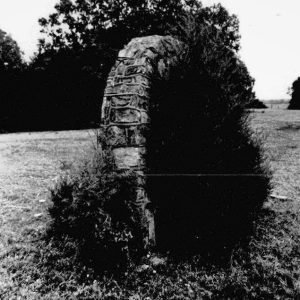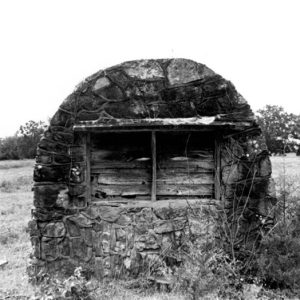calsfoundation@cals.org
Camp Halsey
Camp Halsey was a Soil Conservation Service camp established in 1934 a few miles to the east of Greenbrier in the northeastern corner of Faulkner County. It later became a forestry camp before closing in 1939. In the twenty-first century, the site is archaeological site 3FA313. The location is about one mile east of Woolly Hollow State Park. The small community of Centerville (Faulkner County) is located about one mile to the west of the camp location.
In response to expansive droughts in the early twentieth century, the U.S. government established “demonstration projects” tied to programs of soil conservation within watersheds. The Cadron Creek Demonstration Project was one of the first of these in Arkansas, although it was not affiliated with a residential camp. With the creation of the Civilian Conservation Corps (CCC), federal officials ensured that demonstration project areas received one or more residential camps to provide participating farmers with additional labor to handle the labor-intensive parts of soil conservation. Soil Conservation Service (SCS) camps were created in 1933–34 to facilitate this need and to train enrollees in a wide variety of soil conservation and erosion control work, including terracing, fencing, sodding pastures, controlling gullies, seeding fields, and protecting streams and banks. Skills acquired by enrollees were anticipated as transferable to employers after their camp tenure was completed. Camp Halsey was one of numerous residential SCS camps managed by the CCC program that supported the Cadron Creek watershed project.
Camp Halsey was constructed in late summer 1934 and occupied on October 1, 1934, by men who transferred from Camp Victor, an Ozark forestry camp located in Pope County. Camp Halsey was established as Soil Conservation Service Camp 1, Company 1706. The size of the work area was approximately 125,000 acres and included portions of Faulkner, White, and Cleburne counties. The camp was temporarily abandoned on November 1, 1935, and enrollees were reassigned to neighboring SCS camps, such as Damascus (Van Buren and Faulkner counties) and Heber Springs (Cleburne County). The site was not dismantled and sat vacant throughout 1936 and 1937.
On October 1, 1937, Camp Halsey reopened as forestry camp Company 4748 (P-75). Company 4748 was first established in 1935 at Camp Harrison as an SCS camp performing soil conservation work in the Harrison (Boone County) area. It moved to the Camp Halsey location in 1937 with a new emphasis on private forestland management. By mid-1939, Camp Halsey was again closed, and enrollees were transferred to Camp Paron in Saline County. The lease on the land expired on May 2, 1939, and while remaining buildings were proposed to be moved to Woolly Hollow to serve as meetinghouses for Future Farmers of America (FFA), 4-H, and Boy Scouts and Girl Scouts, they were instead dismantled and removed.
What remains at the present archaeological site are several foundations in varying conditions that represent the locations of former buildings, including barracks and officers’ quarters, supply buildings, an educational building or library, a mess hall with attached kitchen, a latrine and bath house, a hospital, two pump houses, a recreation hall, a garage, and a blacksmith shop.
The two remaining standing structures are a large double-sided chimney that was part of the recreation center and a stone masonry message board. The stone menu board sits alone in the field adjacent to the former Front Street that ran through the center of the camp. Camp officials posted daily announcements of duties, news, and the menu for the day’s meals on this board, which features a “grapevine” style of concrete mortar and is architecturally similar to the message board at Camp Damascus, a camp located a few miles to the north that operated around the same time as Camp Halsey.
A lasting contribution of the Camp Halsey enrollees was the construction of a large earthen dam to create a lake that would allow for a program of water conservation and soil erosion control along with the added benefit of a recreational area. On August 8, 1934, a local pioneer resident and rural storeowner donated land where the dam was to be constructed, and through community donations an additional 280 acres was purchased from the Missouri Pacific Railroad.
The thirty-seven-acre lake that was created as a result of this effort was named after Dr. Hugh Bennett, a soil scientist and conservationist who founded the SCS in 1935 and headed that agency until his retirement in 1951. When the dam was finished and Lake Bennett was filled, Faulkner County Judge J. A. Hutto declared the area the Woolly Hollow Recreation Area on September 2, 1935. The lake became part of Woolly Hollow State Park and is a well-attended recreational spot.
For additional information:
Clark, Sam. “Origin of Lake Bennett.” Faulkner Facts and Fiddlings 13 (Fall 1971): 66–68.
Langley-Ware, Lynita, and Duncan P. McKinnon. “Treating the Sick and Injured at Camp Halsey: Excavation of a ‘Car Infirmary.’” Faulkner Facts and Fiddlings 60 (Fall 2018): 39–53.
McCarty, Joey. “Civilian Conservation Corps in Arkansas.” MA thesis, University of Arkansas, 1977.
Murphy, Michael. “The Rise and Fall of Fire Lookout Towers in Faulkner County: Construction by Company 4748 of the Civilian Conservation Corps, 1937–1939.” Faulkner Facts and Fiddlings 45 (Summer, Fall, Winter 2002): 29–68.
Scott, Billy Joe. “The Development, Construction, and Effects of Lake Bennett.” Faulkner Facts and Fiddlings 36 (Spring/Summer 1994): 1–8.
Smith, Sandra Taylor. “The Civilian Conservation Corps in Arkansas, 1933–1942.” Little Rock: Arkansas Historic Preservation Program. Online at http://www.arkansaspreservation.com/News-and-Events/publications (accessed February 27, 2021).
Duncan P. McKinnon
University of Central Arkansas
 Early Twentieth Century, 1901 through 1940
Early Twentieth Century, 1901 through 1940 Science and Technology
Science and Technology Soils
Soils Camp Halsey Message Board
Camp Halsey Message Board  Camp Halsey Message Board
Camp Halsey Message Board 




Comments
No comments on this entry yet.